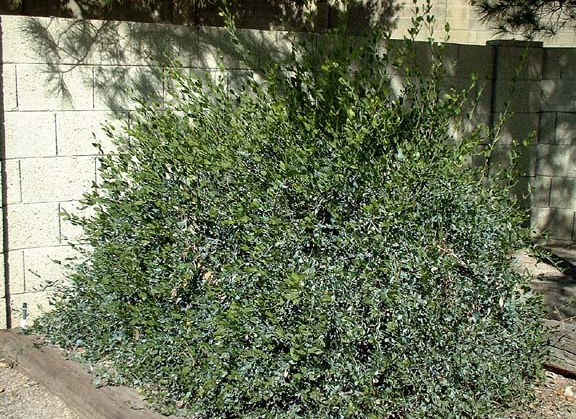Nursery Hours for October-March
Thursday-Saturday: 9:00-5:00 • Wednesday/Sunday: By Appointment
🌲🌲🌲Holiday Schedule🌲🌲🌲
Thanksgiving: Thursday & Friday CLOSED • Saturday OPEN 9:00-5:00
Christmas: 12/23/2025-01/07/2026 CLOSED
Need a gift for the plant person in your life? We have gift cards!
Jojoba
Simmondsia chinensis
false
1 gallon; 3 gallon
Jojoba
Out of stock
3-7'x4-7'
Sizes:
Jojoba – Simmondsia chinensis
Also known as: Goatnut, Deer-nut, Coffee Bush, Quinine Plant
Native to the Sonoran Desert, Simmondsia chinensis is a drought- and fire-resistant evergreen shrub found in desert shrublands and lower chaparral, including the Colorado Desert. It is distributed across southern California, southwestern Arizona, Baja California, and Sonora, Mexico. This adaptable species generally grows in a rounded form to about 7 feet, though specimens can remain compact or grow over 10 feet depending on site conditions. Active growth occurs primarily in summer and fall.
The leathery, bluish-green to medium-green leaves are evergreen, helping the plant survive in the harsh desert sun. Flowers are small and yellowish, with male and female flowers on separate plants (dioecious). Female plants require nearby males to produce the acorn-like fruits, commonly referred to as "goatnuts." These fruits contain oil-rich seeds, highly valued for both wildlife and commercial use.
Jojoba thrives in well-drained, sandy or rocky soils from sea level up to about 4,900 feet. It tolerates high heat, salinity, poor nutrient conditions, and long periods of drought. However, frost can damage or kill plants. In cultivation, it requires some supplemental irrigation to perform as a formal hedge or grouped screen, as stronger plants may suppress their neighbors under drought stress. It is long-lived, with some specimens known to live over 200 years.
Highly valued in desert landscaping, restoration projects, and erosion control, jojoba is also the Sonoran Desert's second most economically important native plant (after Washingtonia filifera), thanks to its seed oil used in cosmetics and industry.
Wildlife Value
Host Plant: —
Nectar Source: —
Bird Resources: Fruit/Nuts; Shelter
Bird Species: Gambel’s Quail (Callipepla gambelii); California Thrasher (Toxostoma redivivum); Phainopepla (Phainopepla nitens); Cactus Wren (Campylorhynchus brunneicapillus)
Mammals: Mule Deer (Odocoileus hemionus); Desert Bighorn Sheep (Ovis canadensis); Jackrabbit (Lepus californicus); various rodents
Livestock: Consumed by domestic sheep, goats, and cattle
Plant Care
Native region:
Local Native; Mojave Desert
Water needs:
Low
Exposure:
Full Sun
Mature size:
3-7'x4-7'
Growth rate:
Moderate
Flower color:
Yellow; Cream
Flower season:
Spring
Pruning:
None needed but can take shaping
Cold Hardiness:
15 Degrees
Nectar-producing:
Yes
Attracts pollinators:
Yes
Nighttime pollinators:
No
Butterflies or Moths:
No
Monarchs:
No
Larval host:
No
Bees:
No
Bats:
No
Birds:
Yes
Nest site:
No
Nest materials:
No
Rabbit-resistant:
No
Tortoises:
No
Growing Plants in the Desert — Important Information
The information presented here is, to the best of my knowledge, accurate and based on reliable research, personal experience in my own garden, observations from other gardens I’ve visited, and time spent studying plants in their native habitats. I always welcome your feedback and experiences to help me continue educating others!
Cacti:
In my experience, cacti are much happier in filtered shade here in the low desert of the Coachella Valley. Their colors are more vibrant and they tend to bloom more profusely, especially the non-native varieties. If you look closely at how our native barrel cactus and beavertail prickly pear grow in the wild, you’ll often find them tucked among rocks or beneath the shelter of creosote and other shrubs.
⚠️ A note of caution: Cacti and succulents are often illegally collected from the wild, which not only damages plant populations but also disturbs entire ecosystems. In some cases, wild populations of cacti have even gone extinct because of this practice. When purchasing these plants, always be sure they’ve been legally obtained. Look for nursery-grown stock or plants with a native plant certification, and keep that documentation for your records.
Light Requirements:
In our desert (Sonoran/Colorado), “full sun” doesn’t always mean what you might think. Many so-called full-sun plants benefit from and actually appreciate some late-afternoon filtered light—especially during the intense summer months.


